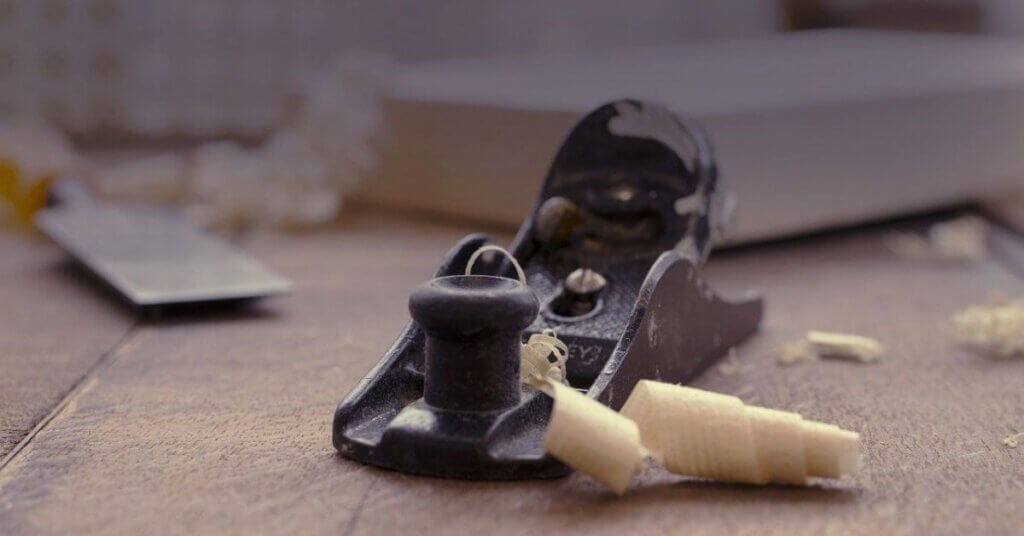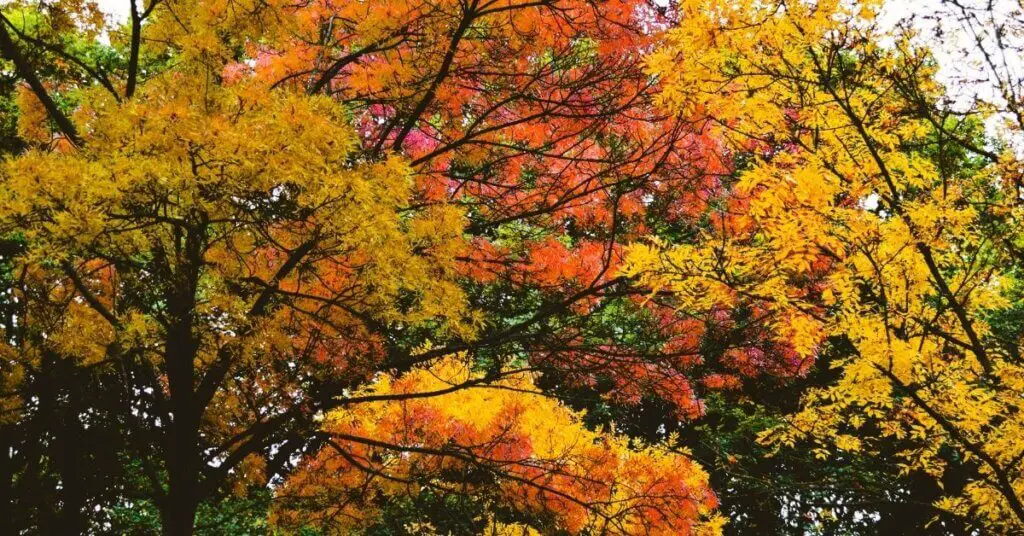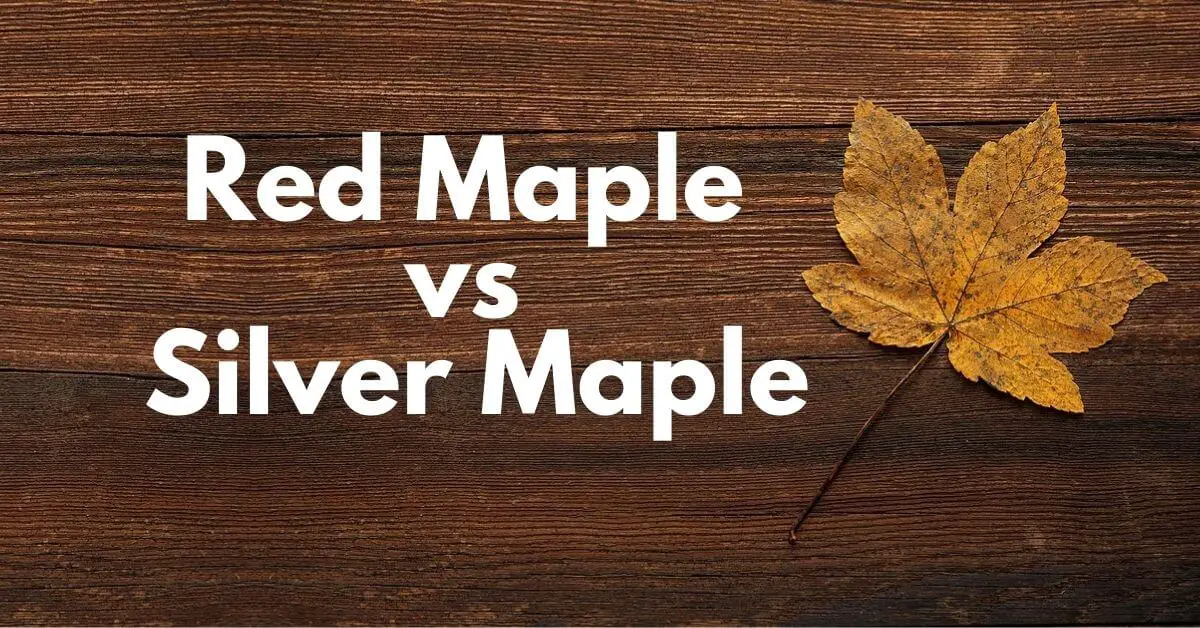Red Maple
Red maple is commonly called soft maple, Swamp, Water Maple. It is native to Eastern and Central North America.
Its red flowers, red fruits, and red twigs attract everyone. It is often found in parks and gardens as an ornamental and shady tree.
Silver Maple
Silver maple is also known as Creek Maple, Silverleaf Maple, Soft Maple, Large Maple, Water Maple, Swamp Maple, or White Maple. It is native to the eastern and central United States and Canada.
Silver Maple also grows as an ornamental and shady tree. It is often found in parks and gardens. It can be easily planted and taken care of.
| # | Red Maple | Silver Maple |
| Scientific Name: | Acer rubrum | Acer saccharinum |
| Native to: | Eastern North America | Northeastern United States |
| Tree Size: | 65-100 ft (20-30 m) tall | 80-115 ft (25-35 m) tall |
| Average Dried Weight: | 38lbs/ft3 (610 kg/m3) | 33 lbs/ft3 (530 kg/m3) |
| Janka Hardness: | 950 lbf (4,230 N) | 700 lbf (3,110 N) |
| Wood color: | light golden or reddish-brown | light golden or reddish-brown |
| Rot Resistance: | Not rot resistant. | not rot resistance |
| Uses: | Veneer, paper (pulpwood), boxes, crates/pallets, musical instruments, etc. | Veneer, paper (pulpwood), boxes, crates/pallets, musical instruments, turned objects, and other small specialty wood items. |
Best uses of Red Maple
Boxes, Crates, and Pallets: Red maple is mainly used for making boxes. To make the quality boxes, it is necessary that the wood should be strong and light in weight. Workability is also great.
Flooring: Red maple is used to make quality flooring. It is less likely to have scratches and dents as compared to silver maple.
Best uses of Silver Maple
Furniture: Silver maple can be turned into timber and to build furniture, cabinets.
Veneer: A veneer sheet is a thin sheet of solid wood that’s been sliced, peeled. Wood veneers can be used to improve the look of creative woodworking projects.
Food: Silver maple is one of the primary food sources for squirrels during the spring.
Red Maple vs Silver Maple Workability

Red maple and silver both have good workability. Fairly easy to work with both hand and machine tools. Some problems may occur while working with high-speed machines, such as a router. Otherwise, It is Turns, glues, and finishes well.
Rot Resistance
Red Maple and silver both are not rot-resistant, and are susceptible to insect attack. It is not suitable for outdoor uses. It starts rotting when it comes in contact with the ground.
You must have to seal maple wood before using for outdoor. Wood sealing protects the natural grain and boosts the wood color.
Do Red Maple and Silver Maple Cause Allergies?
Almost all species of maple have been reported to cause skin irritation, runny nose, and asthma effects. Therefore, while working on Maple, cover the skin and wear glasses. If you already have any allergic problems then take extra precautions.
Growth Rate
Red Maple and Silver Maple are both medium to fast-growing trees. It grows about 12 to 24 inches per year. But the speed of tree growth depends on its climate. All type of maple grows well in moist soil with good drainage but average fertility.
Red Maple vs Silver Maple Identification

| Red Maple | Silver Maple |
| Leaves: Red maple leaves are lobed with 3 to 5 lobes, 6 to 10 inches long. It has a slightly smaller leaf than most other species of maples. The lower lobes are much smaller than the upper. Green stems turn red in winter. In autumn, the leaves of red maple often turn red or purple. Bark: The bark of a young tree looks light brown and smooth. Whereas in the old tree it becomes dark and rough. Flower: The red flowers sprout before the leaf shoots. Flowering occurs in March – April month. Red Maples produce male and female flowers on the same tree. But there is a difference in their size. Fruit: Red maple fruits are called samaras. They look different from typical fruits. Fruit color ranges from red to green, becoming tan with age. Its fruit is 1/2-1 inch long. | Leaves: Silver maple leaves are palmately lobed with 5 deep lobes. The middle lobes are big and the two side lobes are small. The leaves are 8 – 16 cm long and 6 – 12 cm broad. Bark: The bark of a young tree looks light brown and smooth. As the trees get older the bark longitudinally fissured. Flower: green and red flowers sprout before the leaf shoots. The male flower is greenish and the female flower is red. Silver Maples produce male and female flowers on the same tree. Flowering occurs in February – March. Fruit: The paired, winged fruits are called samaras. Green flowers appear along with the shoots before the leaves. The fruit color is Brownish-tan, 1 to 1.2 inches long. |
The Pros and Cons of Having a Red Maple Tree and wood.
| Red maple Pros | Red Maple Cons |
| Fast-growing ornamental tree: It is a fast-growing beautiful ornamental tree. It grows 2 feet per year. Its leaves turn red in the fall. Can be planted easily: Good tolerance of different soil types. Doesn’t require much maintenance. Odor: There is no odor in red maple wood. | Root Problem: Maple trees have shallow roots, so that grass and other trees cannot grow near this tree. Fungal Disease: Red Maple tree is prone to fungal diseases. The fungal pathogens cause small, red-brown, or tan spots to appear on the leaves. Not rot-resistant: Red maple wood is rated as non-durable to perishable in regard to decay resistance. Allergies/Toxicity: Red maple has been reported to cause skin irritation, runny nose, and asthma. |
The Pros and Cons of Having a Silver Maple Tree and wood.
| Silver maple Pros | Silver maple Cons |
| Wide Spread: silver maple may be a better shade tree for the garden and yard. Odor: There is no odor in Silver maple wood. Sustainability: Red maple is not listed in the CITES Appendices or on the IUCN. It is Sustainable wood. | Weak branches: Silver maple branches are large in size. So that it breaks easily in strong wind, which can cause trouble. Not rot-resistant: Silver maple wood is rated as non-durable to perishable in regard to decay resistance. Allergies/Toxicity: Silver maple has been reported to cause skin irritation, runny nose, and asthma. |
Sustainability:
Red and Silver maple both are sustainable wood, Both are not listed in the CITES Appendices or on the IUCN Red List of Threatened Species.

